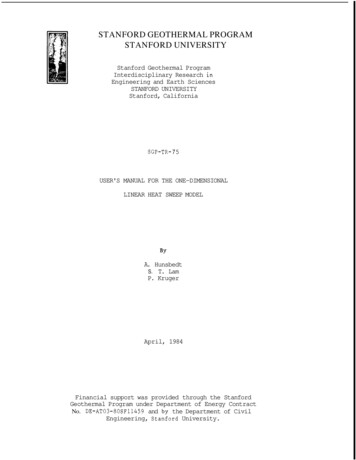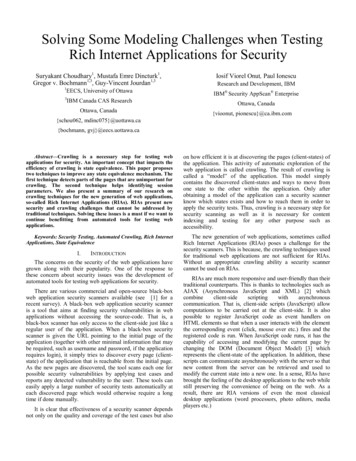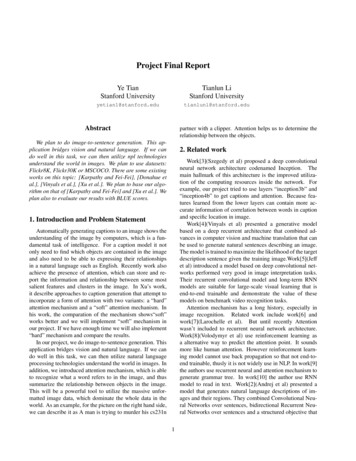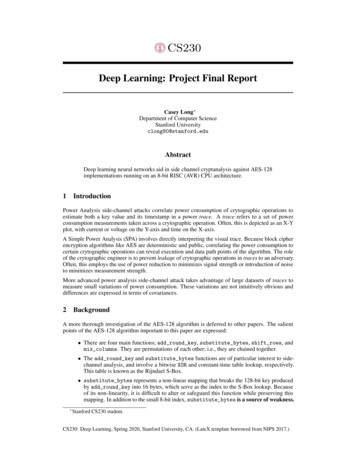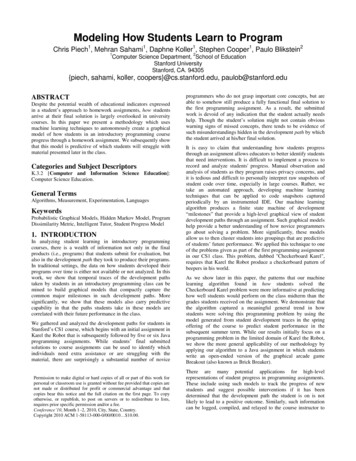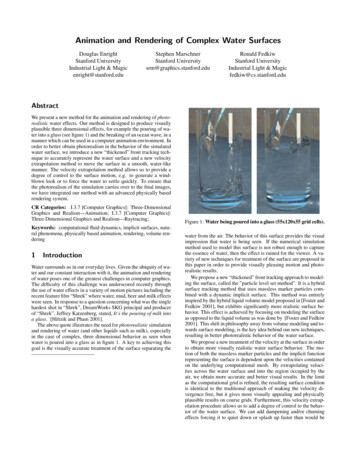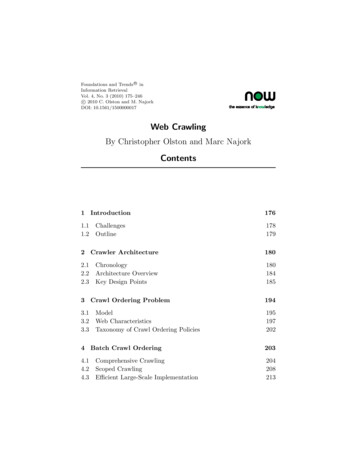
Transcription
RFoundations and Trends inInformation RetrievalVol. 4, No. 3 (2010) 175–246c 2010 C. Olston and M. Najork DOI: 10.1561/1500000017Web CrawlingBy Christopher Olston and Marc NajorkContents1 Introduction1761.11.2178179ChallengesOutline2 Crawler Architecture1802.12.22.3ChronologyArchitecture OverviewKey Design Points1801841853 Crawl Ordering Problem1943.13.23.3195197202ModelWeb CharacteristicsTaxonomy of Crawl Ordering Policies4 Batch Crawl Ordering2034.14.24.3204208213Comprehensive CrawlingScoped CrawlingEfficient Large-Scale Implementation
5 Incremental Crawl Ordering2155.15.25.3217222223Maximizing FreshnessCapturing UpdatesEfficient Large-Scale Implementation6 Avoiding Problematic and Undesirable Content2256.16.26.36.4225226227228Redundant ContentCrawler TrapsWeb SpamCloaked Content7 Deep Web Crawling2307.17.27.3230232232Types of Deep Web SitesProblem OverviewContent Extraction8 Future Directions236References239
RFoundations and Trends inInformation RetrievalVol. 4, No. 3 (2010) 175–246c 2010 C. Olston and M. Najork DOI: 10.1561/1500000017Web CrawlingChristopher Olston1 and Marc Najork212Yahoo! Research, 701 First Avenue, Sunnyvale, CA, 94089, USAolston@yahoo-inc.comMicrosoft Research, 1065 La Avenida, Mountain View, CA, 94043, USAnajork@microsoft.comAbstractThis is a survey of the science and practice of web crawling. While atfirst glance web crawling may appear to be merely an application ofbreadth-first-search, the truth is that there are many challenges rangingfrom systems concerns such as managing very large data structuresto theoretical questions such as how often to revisit evolving contentsources. This survey outlines the fundamental challenges and describesthe state-of-the-art models and solutions. It also highlights avenues forfuture work.
1IntroductionA web crawler (also known as a robot or a spider) is a system for thebulk downloading of web pages. Web crawlers are used for a variety ofpurposes. Most prominently, they are one of the main components ofweb search engines, systems that assemble a corpus of web pages, indexthem, and allow users to issue queries against the index and find the webpages that match the queries. A related use is web archiving (a serviceprovided by e.g., the Internet archive [77]), where large sets of web pagesare periodically collected and archived for posterity. A third use is webdata mining, where web pages are analyzed for statistical properties,or where data analytics is performed on them (an example would beAttributor [7], a company that monitors the web for copyright andtrademark infringements). Finally, web monitoring services allow theirclients to submit standing queries, or triggers, and they continuouslycrawl the web and notify clients of pages that match those queries (anexample would be GigaAlert [64]).The raison d’être for web crawlers lies in the fact that the web isnot a centrally managed repository of information, but rather consists176
177of hundreds of millions of independent web content providers, each oneproviding their own services, and many competing with one another.In other words, the web can be viewed as a federated information repository, held together by a set of agreed-upon protocols and data formats,such as the Transmission Control Protocol (TCP), the Domain NameService (DNS), the Hypertext Transfer Protocol (HTTP), the Hypertext Markup Language (HTML) and the robots exclusion protocol. So,content aggregators (such as search engines or web data miners) havetwo choices: They can either adopt a pull model where they will proactively scour the web for new or updated information, or they couldtry to establish a convention and a set of protocols enabling contentproviders to push content of interest to the aggregators. Indeed, theHarvest system [24], one of the earliest search services, adopted sucha push model. However, this approach did not succeed, and virtuallyall content aggregators adopted the pull approach, with a few provisos to allow content providers to exclude all or part of their contentfrom being crawled (the robots exclusion protocol) and to provide hintsabout their content, its importance and its rate of change (the Sitemapsprotocol [110]).There are several reasons why the push model did not become theprimary means of acquiring content for search engines and other contentaggregators: The fact that web servers are highly autonomous meansthat the barrier of entry to becoming a content provider is quite low,and the fact that the web protocols were at least initially extremelysimple lowered the barrier even further — in fact, this simplicity isviewed by many as the reason why the web succeeded where earlierhypertext systems had failed. Adding push protocols would have complicated the set of web protocols and thus raised the barrier of entry forcontent providers, while the pull model does not require any extra protocols. By the same token, the pull model lowers the barrier of entry forcontent aggregators as well: Launching a crawler does not require anya priori buy-in from content providers, and indeed there are over 1,500operating crawlers [47], extending far beyond the systems employed bythe big search engines. Finally, the push model requires a trust relationship between content provider and content aggregator, something thatis not given on the web at large — indeed, the relationship between
178Introductioncontent providers and search engines is characterized by both mutualdependence and adversarial dynamics (see Section 6).1.1ChallengesThe basic web crawling algorithm is simple: Given a set of seed Uniform Resource Locators (URLs), a crawler downloads all the web pagesaddressed by the URLs, extracts the hyperlinks contained in the pages,and iteratively downloads the web pages addressed by these hyperlinks.Despite the apparent simplicity of this basic algorithm, web crawlinghas many inherent challenges: Scale. The web is very large and continually evolving.Crawlers that seek broad coverage and good freshness mustachieve extremely high throughput, which poses many difficult engineering problems. Modern search engine companiesemploy thousands of computers and dozens of high-speednetwork links. Content selection tradeoffs. Even the highest-throughputcrawlers do not purport to crawl the whole web, or keep upwith all the changes. Instead, crawling is performed selectively and in a carefully controlled order. The goals are toacquire high-value content quickly, ensure eventual coverageof all reasonable content, and bypass low-quality, irrelevant,redundant, and malicious content. The crawler must balancecompeting objectives such as coverage and freshness, whileobeying constraints such as per-site rate limitations. A balance must also be struck between exploration of potentiallyuseful content, and exploitation of content already known tobe useful. Social obligations. Crawlers should be “good citizens” ofthe web, i.e., not impose too much of a burden on the websites they crawl. In fact, without the right safety mechanisms a high-throughput crawler can inadvertently carry outa denial-of-service attack. Adversaries. Some content providers seek to inject useless or misleading content into the corpus assembled by
1.2 Outline179the crawler. Such behavior is often motivated by financialincentives, for example (mis)directing traffic to commercialweb sites.1.2OutlineWeb crawling is a many-faceted topic, and as with most interestingtopics it cannot be split into fully orthogonal subtopics. Bearing thatin mind, we structure the survey according to five relatively distinctlines of work that occur in the literature: Building an efficient, robust and scalable crawler (Section 2). Selecting a traversal order of the web graph, assumingcontent is well-behaved and is interconnected via HTMLhyperlinks (Section 4). Scheduling revisitation of previously crawled content (Section 5). Avoiding problematic and undesirable content (Section 6). Crawling so-called “deep web” content, which must beaccessed via HTML forms rather than hyperlinks (Section 7).Section 3 introduces the theoretical crawl ordering problem studiedin Sections 4 and 5, and describes structural and evolutionary properties of the web that influence crawl ordering. Section 8 gives a list ofopen problems.
2Crawler ArchitectureThis section first presents a chronology of web crawler development,and then describes the general architecture and key design points ofmodern scalable crawlers.2.1ChronologyWeb crawlers are almost as old as the web itself. In the spring of 1993,shortly after the launch of NCSA Mosaic, Matthew Gray implementedthe World Wide Web Wanderer [67]. The Wanderer was written in Perland ran on a single machine. It was used until 1996 to collect statisticsabout the evolution of the web. Moreover, the pages crawled by theWanderer were compiled into an index (the “Wandex”), thus givingrise to the first search engine on the web. In December 1993, threemore crawler-based Internet Search engines became available: JumpStation (implemented by Jonathan Fletcher; the design has not beenwritten up), the World Wide Web Worm [90], and the RBSE spider [57].WebCrawler [108] joined the field in April 1994, and MOMspider [61]was described the same year. This first generation of crawlers identifiedsome of the defining issues in web crawler design. For example, MOM180
2.1 Chronology181spider considered politeness policies: It limited the rate of requeststo each site, it allowed web sites to exclude themselves from purviewthrough the nascent robots exclusion protocol [83], and it provided a“black-list” mechanism that allowed the crawl operator to exclude sites.WebCrawler supported parallel downloading of web pages by structuring the system into a central crawl manager and 15 separate downloading processes. However, the design of these early crawlers did not focuson scalability, and several of them (RBSE spider and WebCrawler) usedgeneral-purpose database management systems to store the state of thecrawl. Even the original Lycos crawler [89] ran on a single machine, waswritten in Perl, and used Perl’s associative arrays (spilt onto disk usingthe DBM database manager) to maintain the set of URLs to crawl.The following few years saw the arrival of several commercial searchengines (Lycos, Infoseek, Excite, AltaVista, and HotBot), all of whichused crawlers to index tens of millions of pages; however, the design ofthese crawlers remains undocumented.Mike Burner’s description of the Internet Archive crawler [29] wasthe first paper that focused on the challenges caused by the scale of theweb. The Internet Archive crawling system was designed to crawl onthe order of 100 million URLs. At this scale, it is no longer possible tomaintain all the required data in main memory. The solution proposedby the IA paper was to crawl on a site-by-site basis, and to partition the data structures accordingly. The list of URLs to be crawledwas implemented as a disk-based queue per web site. To avoid addingmultiple instances of the same URL to the queue, the IA crawler maintained an in-memory Bloom filter [20] of all the site’s URLs discoveredso far. The crawl progressed by dequeuing a URL, downloading theassociated page, extracting all links, enqueuing freshly discovered onsite links, writing all off-site links to disk, and iterating. Each crawlingprocess crawled 64 sites in parallel, using non-blocking input/output(I/O) and a single thread of control. Occasionally, a batch processwould integrate the off-site link information into the various queues.The IA design made it very easy to throttle requests to a given host,thereby addressing politeness concerns, and DNS and robot exclusionlookups for a given web site were amortized over all the site’s URLscrawled in a single round. However, it is not clear whether the batch
182Crawler Architectureprocess of integrating off-site links into the per-site queues would scaleto substantially larger web crawls.Brin and Page’s 1998 paper outlining the architecture of the firstgeneration Google [25] system contains a short description of theircrawler. The original Google crawling system consisted of a singleURLserver process that maintained the state of the crawl, and aroundfour crawling processes that downloaded pages. Both URLserver andcrawlers were implemented in Python. The crawling process used asynchronous I/O and would typically perform about 300 downloads in parallel. The peak download rate was about 100 pages per second, with anaverage size of 6 KB per page. Brin and Page identified social aspectsof crawling (e.g., dealing with web masters’ complaints) as a majorchallenge in operating a crawling system.With the Mercator web crawler, Heydon and Najork presented a“blueprint design” for web crawlers [75, 94]. Mercator was writtenin Java, highly scalable, and easily extensible. The first version [75]was non-distributed; a later distributed version [94] partitioned theURL space over the crawlers according to host name, and avoided thepotential bottleneck of a centralized URL server. The second Mercatorpaper gave statistics of a 17-day, four-machine crawl that covered891 million pages. Mercator was used in a number of web miningprojects [27, 60, 71, 72, 95], and in 2001 replaced the first-generationAltaVista crawler.Shkapenyuk and Suel’s Polybot web crawler [111] represents another“blueprint design.” Polybot is a distributed system, consisting of acrawl manager process, multiple downloader processes, and a DNSresolver process. The paper describes scalable data structures for theURL frontier and the “seen-URL” set used to avoid crawling the sameURL multiple times; it also discusses techniques for ensuring politeness without slowing down the crawl. Polybot was able to download120 million pages over 18 days using four machines.The IBM WebFountain crawler [56] represented another industrialstrength design. The WebFountain crawler was fully distributed.The three major components were multi-threaded crawling processes(“Ants”), duplicate detection processes responsible for identifyingdownloaded pages with near-duplicate content, and a central controller
2.1 Chronology183process responsible for assigning work to the Ants and for monitoringthe overall state of the system. WebFountain featured a very flexiblecrawl scheduling mechanism that allowed URLs to be prioritized, maintained a politeness policy, and even allowed the policy to be changedon the fly. It was designed from the ground up to support incrementalcrawling, i.e., the process of recrawling pages regularly based on theirhistorical change rate. The WebFountain crawler was written in C and used MPI (the Message Passing Interface) to facilitate communication between the various processes. It was reportedly deployed on acluster of 48 crawling machines [68].UbiCrawler [21] is another scalable distributed web crawler. It usesconsistent hashing to partition URLs according to their host componentacross crawling machines, leading to graceful performance degradationin the event of the failure of a crawling machine. UbiCrawler was able todownload about 10 million pages per day using five crawling machines.UbiCrawler has been used for studies of properties of the Africanweb [22] and to compile several reference collections of web pages [118].Recently, Yan et al. described IRLbot [84], a single-process webcrawler that is able to scale to extremely large web collections withoutperformance degradation. IRLbot features a “seen-URL” data structure that uses only a fixed amount of main memory, and whose performance does not degrade as it grows. The paper describes a crawl thatran over two months and downloaded about 6.4 billion web pages. Inaddition, the authors address the issue of crawler traps (web sites witha large, possibly infinite number of low-utility pages, see Section 6.2),and propose ways to ameliorate the impact of such sites on the crawlingprocess.Finally, there are a number of open-source crawlers, two of whichdeserve special mention. Heritrix [78, 93] is the crawler used by theInternet Archive. It is written in Java and highly componentized,and its design is quite similar to that of Mercator. Heritrix is multithreaded, but not distributed, and as such suitable for conducting moderately sized crawls. The Nutch crawler [62, 81] is written in Java aswell. It supports distributed operation and should therefore be suitablefor very large crawls; but as of the writing of [81] it has not been scaledbeyond 100 million pages.
184Crawler Architecture2.2Architecture OverviewFigure 2.1 shows the high-level architecture of a prototypical distributed web crawler. The crawler consists of multiple processes running on different machines connected by a high-speed network. Eachcrawling process consists of multiple worker threads, and each workerthread performs repeated work cycles.At the beginning of each work cycle, a worker obtains a URL fromthe Frontier data structure, which dispenses URLs according to theirpriority and to politeness policies. The worker thread then invokes theHTTP fetcher. The fetcher first calls a DNS sub-module to resolve thehost component of the URL into the IP address of the correspondingweb server (using cached results of prior resolutions if possible), andthen connects to the web server, checks for any robots exclusion rules(which typically are cached as well), and attempts to download the webpage.If the download succeeds, the web page may or may not be storedin a repository of harvested web pages (not shown). In either case, thepage is passed to the Link extractor, which parses the page’s HTMLcontent and extracts hyperlinks contained therein. The correspondingURLs are then passed to a URL distributor, which assigns each URLto a crawling process. This assignment is typically made by hashingthe URLs host component, its domain, or its IP address (the latterrequires additional DNS resolutions). Since most hyperlinks refer topages on the same web site, assignment to the local crawling process isthe common case.Next, the URL passes through the Custom URL filter (e.g., toexclude URLs belonging to “black-listed” sites, or URLs with particular file extensions that are not of interest) and into the Duplicate URLeliminator, which maintains the set of all URLs discovered so far andpasses on only never-before-seen URLs. Finally, the URL prioritizerselects a position for the URL in the Frontier, based on factors such asestimated page importance or rate of change.11 Changerates play a role in incremental crawlers (Section 2.3.5), which route fetched URLsback to the prioritizer and Frontier.
2.3 Key Design PointsCrawling process 1Crawling process 2DNS resolver &cacheDNS resolver &cacheDNS serversHost namesWeb serversIP addressesHost namesHTTP fetcherURLsURL distributorURLsURLsDuplicate URLeliminatorURLsURL prioritizerURLsFrontierWeb serversLink extractorURLsCustom URL filterIP addressesHTML pagesLink extractorURLsDNS serversHTTP fetcherHTML pages185URL distributorURLsURLsURLsCustom URL filterURLsURLsDuplicate URLeliminatorURLsURL prioritizerURLsFrontierFig. 2.1 Basic crawler architecture.2.3Key Design PointsWeb crawlers download web pages by starting from one or moreseed URLs, downloading each of the associated pages, extracting the
186Crawler Architecturehyperlink URLs contained therein, and recursively downloading thosepages. Therefore, any web crawler needs to keep track both of theURLs that are to be downloaded, as well as those that have alreadybeen downloaded (to avoid unintentionally downloading the same pagerepeatedly). The required state is a set of URLs, each associated witha flag indicating whether the page has been downloaded. The operations that must be supported are: Adding a new URL, retrieving aURL, marking a URL as downloaded, and testing whether the set contains a URL. There are many alternative in-memory data structures(e.g., trees or sorted lists) that support these operations. However, suchan implementation does not scale to web corpus sizes that exceed theamount of memory available on a single machine.To scale beyond this limitation, one could either maintain the datastructure (e.g., the tree or sorted list) on disk, or use an off-the-shelfdatabase management system. Either solution allows maintaining setsizes that exceed main memory; however, the cost of accessing items inthe set (particularly for the purpose of set membership test) typicallyinvolves a disk seek, making it a fairly expensive operation. To achievehigh performance, a more specialized approach is needed.Virtually every modern web crawler splits the crawl state into twomajor data structures: One data structure for maintaining the set ofURLs that have been discovered (whether downloaded or not), anda second data structure for maintaining the set of URLs that haveyet to be downloaded. The first data structure (sometimes called the“URL-seen test” or the “duplicated URL eliminator”) must support setaddition and set membership testing, while the second data structure(usually called the frontier) must support adding URLs, and selectinga URL to fetch next.2.3.1Frontier Data Structure and PolitenessA straightforward implementation of the frontier data structure is aFirst-in-First-out (FIFO) queue. Such an implementation results in abreadth-first traversal of the web graph. However, this simple approachhas drawbacks: Most hyperlinks on the web are “relative” (i.e., referto another page on the same web server). Therefore, a frontier realized
2.3 Key Design Points187as a FIFO queue contains long runs of URLs referring to pages onthe same web server, resulting in the crawler issuing many consecutiveHTTP requests to that server. A barrage of requests in short orderis considered “impolite,” and may be construed as a denial-of-serviceattack on the web server. On the other hand, it would be wasteful forthe web crawler to space out requests to the same server without doingother useful work in the meantime. This problem is compounded in amultithreaded or distributed crawler that issues many HTTP requestsin parallel.Most web crawlers obey a policy of not issuing multiple overlappingrequests to the same server. An easy way to realize this is to maintain amapping from web servers to crawling threads, e.g., by hashing the hostcomponent of each URL.2 In this design, each crawling thread has a separate FIFO queue, and downloads only URLs obtained from that queue.A more conservative politeness policy is to space out requests toeach web server according to that server’s capabilities. For example, acrawler may have a policy to delay subsequent requests to a server by amultiple (say 10 ) of the time it took to download the last page fromthat server. This policy ensures that the crawler consumes a boundedfraction of the web server’s resources. It also means that in a given timeinterval, fewer pages will be downloaded from slow or poorly connectedweb servers than from fast, responsive web servers. In other words,this crawling policy is biased toward well-provisioned web sites. Such apolicy is well-suited to the objectives of search engines, since large andpopular web sites tend also to be well-provisioned.The Mercator web crawler implemented such an adaptive politenesspolicy. It divided the frontier into two parts, a “front end” and a “backend.” The front end consisted of a single queue Q, and URLs wereadded to the frontier by enqueuing them into that queue. The back2 Toamortize hardware cost, many web servers use virtual hosting, meaning that multiplesymbolic host names resolve to the same IP address. Simply hashing the host componentof each URL to govern politeness has the potential to overload such web servers. A betterscheme is to resolve the URLs symbolic host name to an IP address and use a hash of thataddress to assign URLs to a queue. The drawback of that approach is that the latencyof DNS resolution can be high (see Section 2.3.3), but fortunately there tends to be ahigh amount of locality in the stream of discovered host names, thereby making cachingeffective.
188Crawler Architectureend consisted of many separate queues; typically three times as manyqueues as crawling threads. Each queue contained URLs belonging to asingle web server; a table T on the side maintained a mapping from webservers to back-end queues. In addition, associated with each back-endqueue q was a time t at which the next URL from q may be processed.These (q, t) pairs were organized into an in-memory priority queue, withthe pair with lowest t having the highest priority. Each crawling threadobtained a URL to download by removing the highest-priority entry(q, t) from the priority queue, waiting if necessary until time t had beenreached, dequeuing the next URL u from q, downloading it, and finallyreinserting the pair (q, tnow k · x) into the priority queue, where tnowis the current time, x is the amount of time it took to download u, and kis a “politeness parameter”; typically 10. If dequeuing u from q left qempty, the crawling thread would remove the mapping from host(u)to q from T , repeatedly dequeue a URL u from Q and enqueue u intothe back-end queue identified by T (host(u )), until it found a u suchthat host(u ) was not contained in T . At this point, it would enqueueu in q and update T to map host(u ) to q.In addition to obeying politeness policies that govern the rate atwhich pages are downloaded from a given web site, web crawlers mayalso want to prioritize the URLs in the frontier. For example, it maybe desirable to prioritize pages according to their estimated usefulness(based for example on their PageRank [101], the traffic they receive,the reputation of the web site, or the rate at which the page hasbeen updated in the past). The page ordering question is discussed inSection 4.Assuming a mechanism for assigning crawl priorities to web pages, acrawler can structure the frontier (or in the Mercator design describedabove, the front-end queue) as a disk-based priority queue ordered byusefulness. The standard implementation of a priority queue is a heap,and insertions into a heap of n elements require log(n) element accesses,each access potentially causing a disk seek, which would limit the datastructure to a few hundred insertions per second — far less than theURL ingress required for high-performance crawling.An alternative solution is to “discretize” priorities into a fixed number of priority levels (say 10 to 100 levels), and maintain a separate URL
2.3 Key Design Points189FIFO queue for each level. A URL is assigned a discrete priority level,and inserted into the corresponding queue. To dequeue a URL, eitherthe highest-priority nonempty queue is chosen, or a randomized policybiased toward higher-priority queues is employed.2.3.2URL Seen TestAs outlined above, the second major data structure in any moderncrawler keeps track of the set of URLs that have been previously discovered and added to frontier. The purpose of this data structure isto avoid adding multiple instances of the same URL to the frontier;for this reason, it is sometimes called the URL-seen test (UST) or theduplicate URL eliminator (DUE). In a simple batch crawling settingin which pages are downloaded only once, the UST needs to supportinsertion and set membership testing; in a continuous crawling settingin which pages are periodically re-downloaded (see Section 2.3.5), itmust also support deletion, in order to cope with URLs that no longerpoint to a valid page.There are multiple straightforward in-memory implementations ofa UST, e.g., a hash table or Bloom filter [20]. As mentioned above, inmemory implementations do not scale to arbitrarily large web corpora;however, they scale much further than in-memory implementations ofthe frontier, since each URL can be compressed to a much smallertoken (e.g., a 10-byte hash value). Commercial search engines employdistributed crawlers (Section 2.3.4), and a hash table realizing the USTcan be partitioned across the machines in the crawling cluster, furtherincreasing the limit of how far such an in-memory implementation canbe scaled out.If memory is at a premium, the state of the UST must reside ondisk. In a disk-based hash table, each lookup requires a disk seek,severely limiting the throughput. Caching popular URLs can increasethe throughput by about an order of magnitude [27] to a few thousandlookups per second, but given that the average web page contains onthe order of a hundred links and that each link needs to be tested fornovelty, the crawling rate would still be limited to tens of pages persecond under such an implementation.
190Crawler ArchitectureWhile the latency of disk seeks is poor (a few hundred seeks persecond), the bandwidth of disk reads and writes is quite high (on theorder of 50–100 MB per second in modern disks). So, implementationsperforming random file accesses perform poorly, but those that performstreaming sequential reads or writes can achieve reasonable throughput. The Mercator crawler leveraged this observation by aggregatingmany set lookup and insertion operations into a single large batch, andprocessing this batch by sequentially reading a set of sorted URL hashesfrom disk and writing them (plus the hashes of previously undiscoveredURLs) out to a new file [94].This approach implies that the set membership is delayed: We onlyknow whether a URL is new after the batch containing the URL hasbeen merged with the disk file. Therefore, we cannot decide whetherto add the URL to the frontier until the merge occurs, i.e., we needto retain all the URLs in a batch, not just their hashes. However, it ispossible to store these URLs temporarily on disk and read them backat the conclusion of the merge (again using purely sequential I/O),once it is known that they had not previously been encountered andshould thus be added to the frontier. Adding URLs to the frontier ina delayed fashion also means that there is a lower bound on how soonthey can be crawled; h
dependence and adversarial dynamics (see Section 6). 1.1 Challenges The basic web crawling algorithm is simple: Given a set of seed Uni-form Resource Locators (URLs), a crawler downloads all the web pages addressed by the URLs, extracts the hyperlinks contained in the pages, and iteratively downloads the web pages addressed by these hyperlinks.
